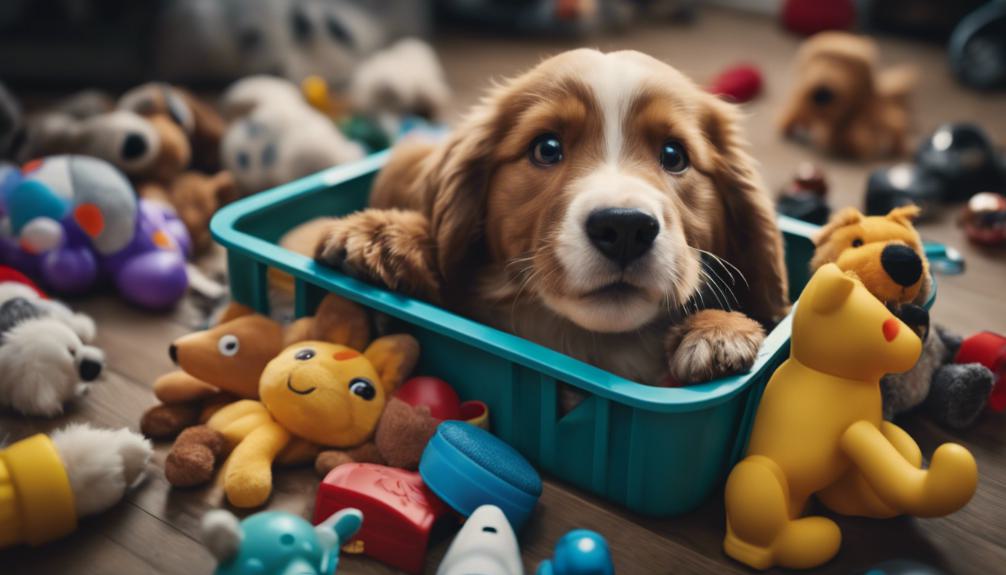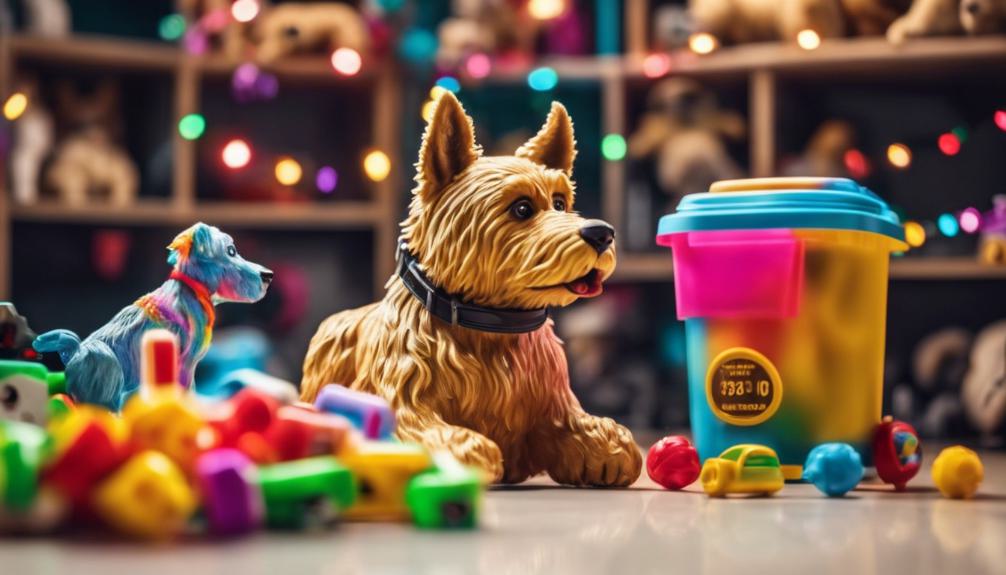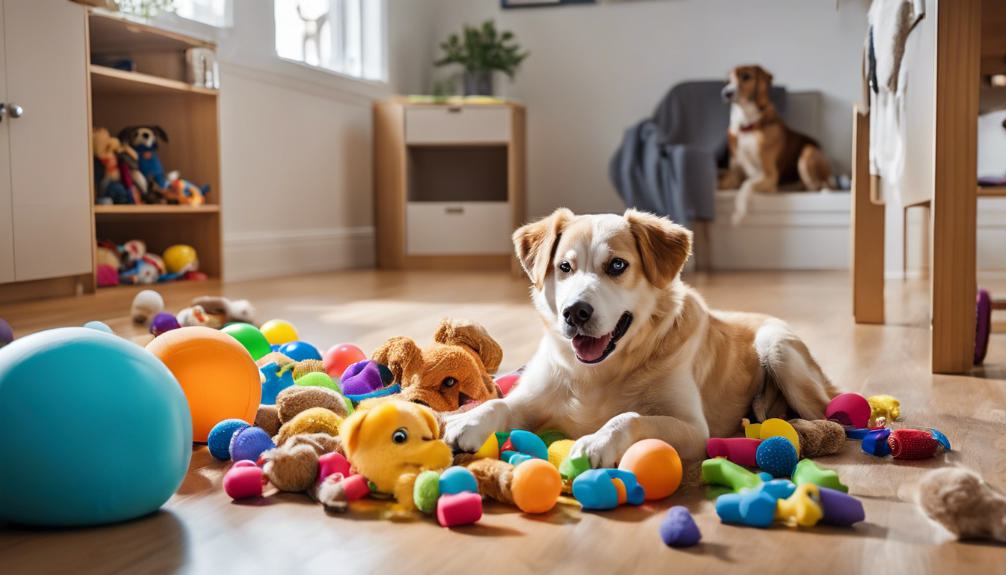How to Train Your Dog to Put Away Toys? Organized Play Tips
To teach your dog to put away toys, start with fetch training using treats and praise. Establish cues like ‘Take It‘ and ‘Drop It‘ for interaction. Introduce tidying up by designating a specific toy box. Use positive reinforcement and make cleaning fun with treats. If your dog lacks response, use high-value treats and break down training steps. Keep training consistent and be patient. Encourage picking up one toy at a time. For advanced training, gradually increase challenge and keep playtime engaging. Create a positive environment to motivate your dog. Mastering these strategies guarantees a tidy and playful pup.
Fetch Training Basics
To begin teaching your dog to put away toys, start with the basics of fetch training. Choose a favorite toy that your dog loves to chase and retrieve. By incorporating this toy into fetch training, you establish a connection between playtime and tidying up.
Encourage your dog to fetch the toy, offering treats and praise for bringing it back to you. Gradually increase the distance of the fetch to simulate putting toys away in a specific spot. This process helps your dog understand the concept of retrieving and storing toys.
Consistent fetch training sessions will improve your dog’s ability to retrieve items, setting the stage for learning how to put away toys in an organized manner.
Teaching ‘Take It’ and ‘Drop It’
Start by consistently using the ‘Take It‘ command to excite your dog with a toy and establish a clear association between the command and playtime. Once your pup grabs the toy, introduce the ‘Drop It‘ command by offering a tasty treat to encourage him to let go.
Progress to the next step only at the time your dog consistently follows both commands. High-value treats like chicken can be a great motivator for your furry friend to put his toys away whenever instructed.
Introduction to Tidying Up

When introducing tidying up to your dog, engage in interactive and enjoyable activities that promote organization and mental stimulation. Start by designating a specific toy box for your dog’s belongings. Teach your dog to recognize this box as the designated spot for their toys.
Encourage your pet to pick up a toy and place it in the box using positive reinforcement techniques. Make the process fun by turning it into a game or incorporating treats as rewards.
This training not only helps keep your home tidy but also provides mental enrichment for your furry friend. By incorporating tidying up into your playtime routine, you’re strengthening the bond with your dog while enhancing their obedience skills and overall learning experience.
Using Positive Reinforcement
When teaching your dog to put away toys, remember that positive reinforcement is key. By rewarding good behavior with treats or praise, you can encourage your dog to tidy up regularly.
Consistency in your training schedule will help reinforce this positive association between cleaning up and receiving a reward.
Rewarding Good Behavior
Reward good behavior by using positive reinforcement, such as treats and praise, at the moment your dog puts away toys. As soon as your dog successfully drops a toy in the designated spot, immediately offer a tasty treat accompanied by enthusiastic praise.
This positive association encourages your furry friend to continue participating in the cleanup process. By consistently rewarding the desired behavior, like putting toys away, your dog learns that tidying up results in a delicious reward and your approval.
Using treats as a reward helps your dog understand that cleaning up is a fun and rewarding activity. Remember, positive reinforcement with treats is a powerful tool in motivating your dog to engage in organized play and maintain good behavior.
Consistent Training Schedule
To guarantee successful training for your dog in putting away toys, maintaining a consistent schedule is key, reinforcing positive behavior through regular practice sessions. By setting aside specific times each day to work on this skill, you create a structured routine that helps your dog understand expectations.
Positive reinforcement, such as treats or praise, during these scheduled training sessions motivates your dog to consistently put away toys. Remember to use cues like ‘Say drop’ to signal the desired behavior.
To further enhance training effectiveness, consider incorporating a visual aid like setting the basket where toys should be placed. Consistency in your training schedule not only reinforces the behavior but also keeps your dog engaged and enthusiastic to learn.
Troubleshooting Lack of Response

If your dog isn’t responding well to the training, try using high-value treats like chicken to boost motivation. Make sure your furry friend fully understands the drop it command before moving on to putting toys away.
Break down the training into smaller steps, maintain a consistent schedule, and remember to be patient and persistent throughout the process.
Reinforcement for Motivation
Experiment with various high-value treats like chicken to discover what truly motivates your dog in training sessions. Some dogs may respond better to different types of treats, so it’s essential to find what really gets their tail wagging.
Whenever your dog successfully puts away a toy, reward them immediately with the high-value treat. This positive reinforcement helps solidify the desired behavior. Consistency is key in dog training, so make sure to reinforce good behavior every time your dog completes the task.
In addition to treats, incorporate play and praise as extra forms of motivation. By adjusting your training approach based on your dog’s preferences and responses, you can create a fun and engaging training environment that keeps your pup excited to learn.
Consistent Training Schedule
Establishing a consistent training schedule is essential for troubleshooting any lack of response from your dog when teaching them to put away toys. Daily sessions help reinforce the behavior, allowing your dog to understand and remember the desired action.
Using the same cues and commands consistently is key to helping your dog know what’s expected of them. Stay positive and patient during training sessions to keep your dog engaged and responsive.
If your dog shows a lack of response, consider adjusting your training methods, such as using higher value treats or toys to motivate them. Remember, seeking guidance from a professional dog trainer can also be beneficial if you encounter persistent difficulties in getting your dog to put away toys.
Patience and Persistence
To effectively troubleshoot any lack of response from your dog when training them to put away toys, maintain a steady use of high-value treats and positive reinforcement throughout the sessions. Make sure you are patient and persistent, as some dogs may take longer to grasp the tidying concept. Break down the training into smaller steps and practice each step until your dog reliably responds. Gradually increase the distance at which you ask your dog to put away the toys to challenge them progressively. If you notice your dog losing interest or not responding as expected, adapt your training approach accordingly. Celebrate small successes to keep your dog motivated. Here is a table to provide you with a visual guide:
| Persistence | Patience | Outcome |
|---|---|---|
| Consistent effort | Calm and collected | Successful training |
Celebrating Small Wins

Upon your dog successfully puts away a toy, make sure to enthusiastically praise their effort to celebrate these small wins.
Use high-value treats as a reward for each achievement in the tidying training process. Establish a reward system where your dog receives a treat or favorite toy for each toy placed in the designated spot.
Acknowledge and encourage any effort your dog makes to engage in the tidying behavior, no matter how small. Consistent positive reinforcement for each small win will motivate your dog to continue tidying up his toys.
Maintaining Consistency in Training
Consistently reinforcing positive behavior is key to effectively training your dog to put away toys. By maintaining consistent training sessions, you’re helping your dog build a strong foundation for learning the trick.
Guarantee that positive reinforcement is consistently used throughout the teaching process to encourage your dog’s progress. It’s important that your dog reliably drops the toy in the designated spot before moving on to the next step.
Training the Tidy Up trick requires consistency in teaching each step to help your dog understand and master the task over time. Remember, patience and repetition are essential in maintaining consistency during training sessions.
Stick to a routine and praise your dog for each small achievement to keep them engaged and motivated.
Making Playtime Organized

As you organize playtime for your dog, start by designating a specific spot for their toy basket to establish a consistent storage location. Make sure to encourage your dog to pick up one toy at a time and place it in the basket.
Positive reinforcement, such as treats, praise, and play, can motivate your furry friend to put away toys. Regular practice will help reinforce this behavior, turning tidying up into a fun and interactive activity.
For advanced training, gradually increase the challenge by adding more toys or placing the basket further away. By making playtime organized and engaging, you can teach your dog the importance of cleaning up after themselves while having a blast.
Frequently Asked Questions
How Do I Teach My Dog to Put His Toys Away?
To teach your dog to put away toys, start with ‘take it’ and ‘drop it’ commands. Reward with tasty treats for putting toys in a designated spot. Increase distance gradually for a challenge. Consistent practice, praise, and patience are key.
How Do I Train My Dog to Leave Kids Toys Alone?
To teach your dog to leave kids’ toys alone, use positive reinforcement and teach a ‘leave it’ command. Supervise interactions to prevent access, provide alternate toys, and be consistent. Patience is crucial for successful training.
How Do I Teach My Dog to Return a Toy?
Teach your dog the ‘take it’ command, encouraging them with treats to return the toy. Practice ‘drop it’ to release the toy and gradually introduce putting it in a designated spot. Stay consistent and patient.
Why Does My Dog Play Keep Away With Toys?
Your dog might play keep away with toys due to natural instincts, seeking attention, enjoying the chase, or enticing you to join in the fun. Grasping these motivations can help modify behavior through training and positive reinforcement.
Conclusion
With patience, consistency, and positive reinforcement, training your dog to put away toys can be a fun and rewarding experience for both you and your furry friend.
Remember to celebrate small wins, maintain a structured playtime, and troubleshoot any challenges that may arise.
By following these organized play tips, you’ll soon have a well-trained pup who can help keep their toys tidy and your home clutter-free.
Happy training!

